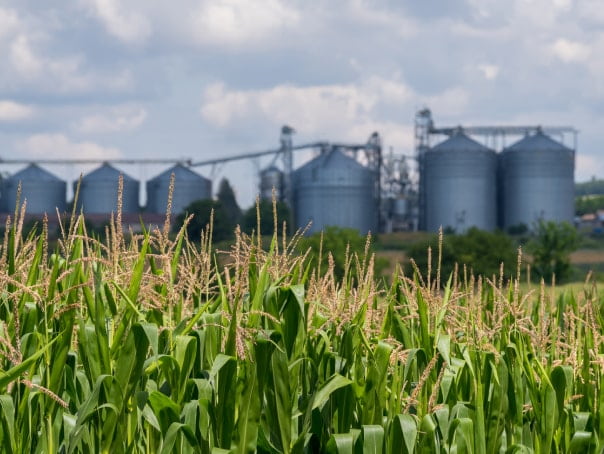August 2023 Agriculture Industry Update
The sun is beginning to set on summertime, meaning farmers nationwide are gearing up for Harvest. Harvest has already begun for some southern states and growers in the middle part of the country are preparing machinery for another fall reaping. 2023 has brought unique challenges and opportunities to farm producers from an ongoing Russian-Ukrainian conflict to varying drought conditions in parts of the United States. Long-term estimates for agricultural commodity demand remain strong as the world population grows demanding more food and new energy sources. Technology advancements in soybean’s potential as a biofuel and jet fuel have unlocked new potential demand for one of the United States’ largest cash crops. As a result, farmland values have remained strong in much of the United States, particularly the Midwest. The 2023 USDA Land Values Summary showed slowing growth rates compared to 2022 however cropland values continued to rise 8.1% from 2022 to 2023 to an average of $5,460 per acre. This United States Department of Agriculture (USDA) report suggests a promising future for the Promised Land Opportunity Zone Fund I (PLOZ Fund I) as we execute on our rural development mission to revitalize rural communities while providing investors with a tax-advantaged investment vehicle.
Crop Progress Update
Agriculture is unique because it is one of the few sectors whose output is largely dependent on weather conditions. Not only do weather conditions affect the size of the crop, but they also can affect the prices received as futures markets react to incoming news of rain, drought, wind, or other weather changes. 2022 brought about drought concerns throughout the United States as California, Kansas, and several western states suffered from exceptional drought conditions. The drought decimated water supplies and yields of a variety of crops such as vegetables, fruits, bulk commodities, and nut trees. The American Farm Bureau estimated more than $20 billion in crop losses due to drought or wildfires, pressing farm incomes and profit in certain geographies. On the flip side, the Corn Belt saw strong net incomes and yields as more favorable weather conditions left many states in that region unaffected.

The drought that affected much of the West in 2022 has started to work its way east toward key bulk commodity states, bringing concerns of a diminished harvest in 2023. While parts of Texas are still suffering from last year’s drought, California, Nevada, and Utah have largely emerged from their concerning situations. Farmers in these areas were beginning to feel pressure from communities and local officials as they debated whether to use water for irrigation of crops or human consumption. One region that has remained mostly unscathed is the eastern United States which is good news for Promised Land as our largest farm in the PLOZ Fund I, the McCotter farm sits on the east coast of North Carolina in Pamlico County. PLOZ Fund I also has three farms in South Carolina and two farms in Mississippi. Geographic diversification was an important consideration in the construction of the Promised Land farm portfolio.

The varying drought patterns have impacted the upcoming harvest expectations as many of the operators farming the properties in PLOZ Fund I portfolio will begin harvesting within the next month. In the most recent World Agricultural Supply and Demand Estimates (WASDE) report, the USDA estimated that the average corn and soybean yield (the primary crops in the PLOZ Fund I portfolio) would be 175.1 bushels per acre and 50.9 bushels per acre, respectively. These yield values are lower than the previous report in July which reported corn and soybean yields of 177.5 bushels per acre and 52.0 bushels per acre, respectively. These adjustments came as no surprise to many producers in the Midwest as crucial commodity states such as Iowa, Kansas, and Nebraska are still suffering from drought. Thankfully, for the farms in the PLOZ Fund I portfolio rains came at crucial times and harvest expectations are looking promising.
Financial Update

As a result of the varying drought patterns and other global factors, agricultural commodity prices have fluctuated throughout 2023. Corn and soybeans prices have been trending downward making it unlikely that farmers will reach peak net incomes like they did in 2021 and 2022. Farming is a unique industry in that farm incomes are entirely determined by an uncertain production amount for an uncertain price, meaning farm incomes are not consistent from year to year. However current prices and yield expectations remain favorable for positive farm incomes in the United States. The USDA has estimated national farm incomes to drop off from 2022 however will still remain above the 20-year average net cash farm income. Note that Promised Land tenant's generally pay fixed cash rents. These tenant’s primarily bear the risk and rewards of their labors and the fluctuations in yield and crop prices.
Agricultural commodity markets are influenced by a variety of factors that impact the prices of corn and soybeans. As with any product, it’s all about supply and demand. We have already discussed the supply side, but what about demand? One of the major factors impacting markets since February 2022 is the Russian invasion of Ukraine. Ukraine is known as the breadbasket of Europe as it is one of the top producers for major agricultural commodities such as wheat, sunflowers, and corn. As the conflict persists, commodity markets have adjusted prices and introduced market risk premiums over concerns of whether Ukraine will be able to export its typical substantial amount. Thus far, Ukrainian farmers have remained resilient and are expected to produce a strong harvest in 2023 however it is still unclear whether or not Ukrainian farmers will be able to export their crops. In July 2023, the Kremlin terminated the Black Sea grain deal which previously made it possible for Ukraine to export its grain by sea even while the war ensued. The Black Sea ports are crucial to the export of these large bulk commodities and without access to these ports, parts of the world may go hungry without Ukraine’s crops.
Another major factor that will continue to impact commodity markets in the future is the increased demand for biofuels. As the United States and other developed nations look to reduce their dependence on traditional energy sources such as coal and oil, advancements in biodiesel and aviation biofuel have markets looking toward one staple crop in the Midwest, soybeans. In the past, soybeans have been looked at as “the crop you plant when you don’t plant corn” as it provides the soil with essential nitrogen needed to produce corn and other crops. Many farmers adopt a standard corn and soybean crop rotation as a result. Yet, new demand for soybeans has created price incentives for farmers to consider planting more soybean acres rather than corn in upcoming years.
These demand factors will continue to impact global commodity market pricing; however, the biggest driver remains domestic supply and yield expectations as we have already discussed. 2023 corn and soybean yield numbers will begin to become more concrete in the coming months as the harvest progresses and USDA updates WASDE figures.

Nov ’23 Soybean Futures as of August 14th, 2023

Dec ’23 Corn Futures as of August 14th, 2023
Source: Barchart
Farmland Values Update

For Promised Land OZ investor, a significant determinant of investment performance is expectations surrounding changes in farmland values, driven by farmland cash yield and appreciation potential. 2020-2022 brought about some of the most significant gains in land appreciation and farmland returns as world uncertainty surrounding COVID-19 reminded people that regardless of the world’s status, people still need to eat. Real estate investors became increasingly interested in evaluating farmland as an investment alternative, spurring increased demand for an asset class with a limited supply. Food inflation caused commodity prices to rise which in turn created a positive benefit for farm cash rents and land appreciation. As a majority of the properties in the PLOZ Fund I portfolio were acquired in 2021 and 2022, Promised Land’s portfolio has appreciated nicely.
Early 2023 projections concluded that cropland values would continue to remain strong, but gains would begin to moderate due increasing costs of capital from the Federal Reserve’s interest rate hiking campaign. The USDA confirmed these early estimates in its 2023 Land Values Summary which was released in early August. Much of the United States saw strong increases in values with US farmland appreciating 8.1% in 2023 from 2022 with large gains occurring in Midwest and Eastern states where PLOZ Fund I has a strong presence. While this is still a strong appreciation value, it shows slowed growth from the previous report which reported a 14.3% appreciation nationally from 2021 to 2022.
The estimated fair value of Promised Land’s ten farms purchased in 2021 has appreciated $5.5 million, or 8.5%, above historical cost through June 30, 2023. The two most recent Illinois farms purchased in October and December of 2022 remain at cost.
The USDA reported the following year over year cropland values and per acre average values for each of the states represented in the Promised Land portfolio: Illinois (+7.0%, $9,580), North Carolina (+6.4%, $5,000), South Carolina (+4.8%, $3,300) and Mississippi (2.1%, $3,410). Promised Land OZ will incorporate the latest 2023 USDA Land Values Summary and other valuation inputs into its valuation analysis for the quarter ended September 30, 2023 and anticipates further overall net appreciation in its farm portfolio.
While appreciation has slowed, the data indicates there is still strong demand and interest in U.S. agriculture as an industry and an asset class. Farmland appreciation may continue to moderate towards the end of 2023 and into 2024; however, farmland continues to be an attractive inflation-protected asset class over the long-term hold period for PLOZ Fund I.





